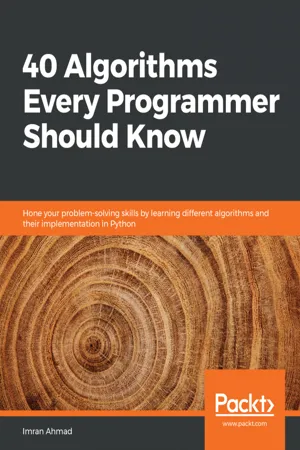
40 Algorithms Every Programmer Should Know
Hone your problem-solving skills by learning different algorithms and their implementation in Python
- 382 pages
- English
- ePUB (mobile friendly)
- Available on iOS & Android
40 Algorithms Every Programmer Should Know
Hone your problem-solving skills by learning different algorithms and their implementation in Python
About this book
Learn algorithms for solving classic computer science problems with this concise guide covering everything from fundamental algorithms, such as sorting and searching, to modern algorithms used in machine learning and cryptography
Key Features
- Learn the techniques you need to know to design algorithms for solving complex problems
- Become familiar with neural networks and deep learning techniques
- Explore different types of algorithms and choose the right data structures for their optimal implementation
Book Description
Algorithms have always played an important role in both the science and practice of computing. Beyond traditional computing, the ability to use algorithms to solve real-world problems is an important skill that any developer or programmer must have. This book will help you not only to develop the skills to select and use an algorithm to solve real-world problems but also to understand how it works.You'll start with an introduction to algorithms and discover various algorithm design techniques, before exploring how to implement different types of algorithms, such as searching and sorting, with the help of practical examples. As you advance to a more complex set of algorithms, you'll learn about linear programming, page ranking, and graphs, and even work with machine learning algorithms, understanding the math and logic behind them. Further on, case studies such as weather prediction, tweet clustering, and movie recommendation engines will show you how to apply these algorithms optimally. Finally, you'll become well versed in techniques that enable parallel processing, giving you the ability to use these algorithms for compute-intensive tasks.By the end of this book, you'll have become adept at solving real-world computational problems by using a wide range of algorithms.
What you will learn
- Explore existing data structures and algorithms found in Python libraries
- Implement graph algorithms for fraud detection using network analysis
- Work with machine learning algorithms to cluster similar tweets and process Twitter data in real time
- Predict the weather using supervised learning algorithms
- Use neural networks for object detection
- Create a recommendation engine that suggests relevant movies to subscribers
- Implement foolproof security using symmetric and asymmetric encryption on Google Cloud Platform (GCP)
Who this book is for
This book is for programmers or developers who want to understand the use of algorithms for problem-solving and writing efficient code. Whether you are a beginner looking to learn the most commonly used algorithms in a clear and concise way or an experienced programmer looking to explore cutting-edge algorithms in data science, machine learning, and cryptography, you'll find this book useful. Although Python programming experience is a must, knowledge of data science will be helpful but not necessary.
]]>
Frequently asked questions
- Essential is ideal for learners and professionals who enjoy exploring a wide range of subjects. Access the Essential Library with 800,000+ trusted titles and best-sellers across business, personal growth, and the humanities. Includes unlimited reading time and Standard Read Aloud voice.
- Complete: Perfect for advanced learners and researchers needing full, unrestricted access. Unlock 1.4M+ books across hundreds of subjects, including academic and specialized titles. The Complete Plan also includes advanced features like Premium Read Aloud and Research Assistant.
Please note we cannot support devices running on iOS 13 and Android 7 or earlier. Learn more about using the app.
Information
Section 1: Fundamentals and Core Algorithms
- Chapter 1, Overview of Algorithms
- Chapter 2, Data Structures used in Algorithms
- Chapter 3, Sorting and Searching Algorithms
- Chapter 4, Designing Algorithms
- Chapter 5, Graph Algorithms
Overview of Algorithms
- What is an algorithm?
- Specifying the logic of an algorithm
- Introducing Python packages
- Algorithm design techniques
- Performance analysis
- Validating an algorithm
What is an algorithm?
The phases of an algorithm

- The design phase: In the design phase, the architecture, logic, and implementation details of the algorithm are envisioned and documented. While designing an algorithm, we keep both accuracy and performance in mind. While searching for the solution to a given problem, in many cases we will end up having more than one alternative algorithm. The design phase of an algorithm is an iterative process that involves comparing different candidate algorithms. Some algorithms may provide simple and fast solutions but may compromise on accuracy. Other algorithms may be very accurate but may take considerable time to run due to their complexity. Some of these complex algorithms may be more efficient than others. Before making a choice, all the inherent tradeoffs of the candidate algorithms should be carefully studied. Particularly for a complex problem, designing an efficient algorithm is really important. A correctly designed algorithm will result in an efficient solution that will be capable of providing both satisfactory performance and reasonable accuracy at the same time.
- The coding phase: In the coding phase, the designed algorithm is converted into a computer program. It is important that the actual program implements all the logic and architecture suggested in the design phase.
Specifying the logic of an algorithm
Table of contents
- Title Page
- Copyright and Credits
- Dedication
- About Packt
- Contributors
- Preface
- Section 1: Fundamentals and Core Algorithms
- Overview of Algorithms
- Data Structures Used in Algorithms
- Sorting and Searching Algorithms
- Designing Algorithms
- Graph Algorithms
- Section 2: Machine Learning Algorithms
- Unsupervised Machine Learning Algorithms
- Traditional Supervised Learning Algorithms
- Neural Network Algorithms
- Algorithms for Natural Language Processing
- Recommendation Engines
- Section 3: Advanced Topics
- Data Algorithms
- Cryptography
- Large-Scale Algorithms
- Practical Considerations
- Other Books You May Enjoy